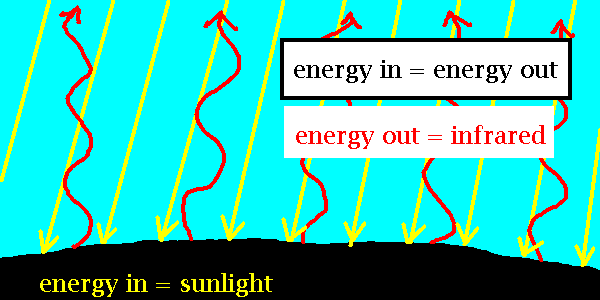Earth's Temperature
Let's ask the question, how hot is the earth?

Of course, we know the answer. But answering will give us a hint about
why.
We don't need to be very exact; we just need a rough estimate.
First, recall how we measure temperature.
Next, think about how thermal energy is transferred.
The basic idea:

How much is the energy in?
- Amount of energy received from Sun per square meter per second:
342 watts/meter2
- Of this, 35% is reflected back into space.
So 65% of 342 watts/(m2 s) is absorbed:
Ein = 220 watts/meter2
How much is the energy out?
Here is how we would calculate in a physics class. (But for our astronomy
class, it is sufficient to understand the general idea. It is, however, important to understand the scientific reasoning because the issue of the temperature of the earth is pretty significant.)
- To be precise, we want the energy radiated per second per square meter from
an ``ideal'' hot surface called a black body .
- It depends on the temperature T (measured in Kelvins).
- It involves a constant
(sigma) = 5.7x10-8 watts/(m2 K4).

Just set these equal:
(sigma) T4 = 220 watts/meter2
so
T4 = 220 watts/meter2/(sigma)
or
T4 = [220 /(5.7x10-8)] K4 = 3.9 x 109 K4
We just need the value of T such that T4 is 3.9 x 109:
T = 250 K
That's pretty close, although 300 K would be closer.
Why are we warmer than the blackbody law would suggest?
ASTR 121 Home
Davison E. Soper, Institute of Theoretical Science,
University of Oregon, Eugene OR 97403 USA
soper@bovine.uoregon.edu



